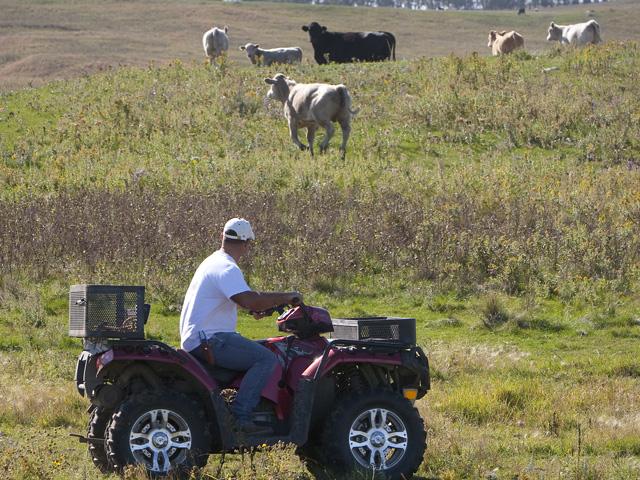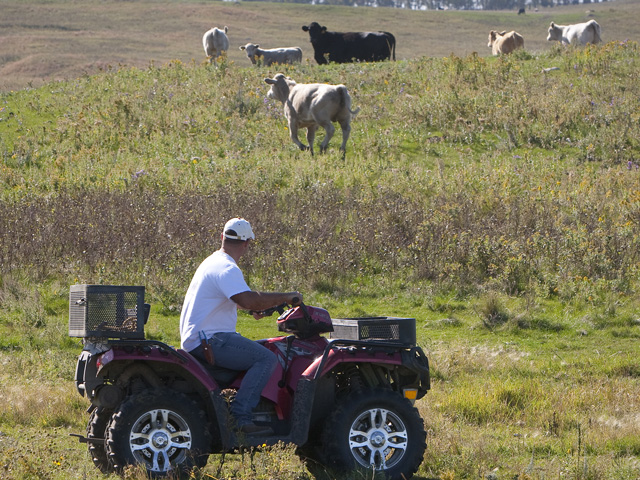MachineryLink
Tips on Operating ATVs, UTVs Safely
When I was kid growing up on our eastern Nebraska farm, my dad purchased an all-terrain vehicle (ATV). This was in the early 1980s and he got a three-wheeler, which he used to check cows, fix fence and occasionally pull us kids on sleds in winter.
Someone stole it right out of one of our buildings one night and we never saw it again. My dad then took the insurance money he got for the three-wheeler and purchased a four-wheel ATV.
It was probably a blessing in disguise the three-wheeler got stolen and we got the four-wheeler because that one additional wheel made the ATV way more stable. I don't know how many times the three-wheeler ended up rolling. We weren't hurt (at least not that I remember), but obviously, we could have been.
Like anything on the farm, if operated correctly, the ATV -- or its cousin, the utility terrain vehicle (UTV) -- is a useful tool that can aid in many different tasks. Used incorrectly, though, ATV's can be extremely dangerous and can lead to injury or death.
In a University of Nebraska-Lincoln (UNL) Extension report titled "Ride Safety This Summer," Susan Harris-Broomfield, UNL Extension educator for rural health, wellness and safety, wrote about some of the safety practices ATV/UTV operators should observe.
The Consumer Product Safety Council reports that 650 people die on ATVs every year and approximately 100,000 are injured, according to Harris-Broomfield. These stats also don't include the many unreported injuries associated with ATVs, she said.
P[L1] D[0x0] M[300x250] OOP[F] ADUNIT[] T[]
Harris-Broomfield said she hopes both adults and children consider four important points before driving an ATV/UTV:
-- An ATV is designed for one person. The center of gravity on an ATV is extremely high, and it doesn't take much to tip it over. Adding a passenger moves the center of gravity higher and farther back.
-- Children should not operate adult-sized ATVs. Roughly 90% to 97% of ATV injuries to youths under age 16 happen when they are operating an adult-sized ATV. Smaller, less powerful ATVs are recommended for youth if they must ride.
-- A common misconception is driving an ATV/UTV on paved or gravel roads is safer than elsewhere when, in fact, half of all accidents happen because people drive them on roads. They are not designed for roads, and their tires are built with deep tread and more gripping area to grab whatever they come across. This makes them much more difficult to control on any kind of road or at high speeds.
-- All drivers should wear helmets when operating ATV/UTVs. The most common injury is to the head, neck and shoulder areas.
Harris-Broomfield also recommended those who operate or ride on UTVs use the seat belts. UTVs are even heavier than ATVs, and when they land on people, the injuries tend to be more severe.
ATV/UTV operators in the state of Nebraska must have a driver's license and have liability insurance, she said. The ATV/UTV must only be used between sunrise and sunset, operators must obey the speed limit of 30 miles per hour, and the UTV/ATV must have operational headlights and taillights.
In addition, ATV/UTVs must have an orange bicycle flag at least 5 feet above the ground, and operators must never drive on any public highway, county road or street. The only exception would be if they are being used for some agricultural purpose.
Harris-Broomfield said some towns allow ATV/UTVs to be used in town. However, operators must follow all town laws within the city limits, she said.
To read the entire UNL report, click on the following link: https://extension.unl.edu/….
Russ Quinn can be reached at russ.quinn@dtn.com
Follow him on Twitter @RussQuinnDTN
© (c) Copyright 2020 DTN, LLC. All rights reserved.






Comments
To comment, please Log In or Join our Community .